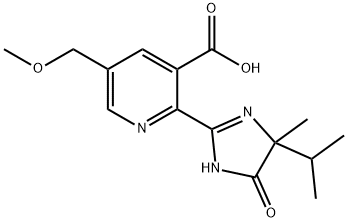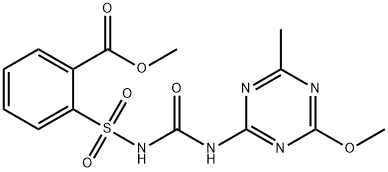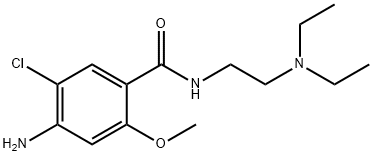Imazamox , ≥99% , 114311-32-9
Synonym(s):
2-(4-Isopropyl-4-methyl-5-oxo-2-imidazolin-2-yl)-5-methoxymethylnicotinic acid;2-[4,5-Dihydro-4-methyl-4-(1-methylethyl)-5-oxo-1H-imidazol-2-yl]-5-(methoxymethyl)-3-pyridinecarboxylic acid;RAPTOR;Regulatory-associated protein of mTOR;RPTOR
| Pack Size | Price | Stock | Quantity |
| 10mg | RMB432.00 | In Stock |
|
| 50mg | RMB604.80 | In Stock |
|
| 250mg | RMB1120.00 | In Stock |
|
| 1g | RMB3360.00 | In Stock |
|
| others | Enquire |
PRODUCT Properties
| Melting point: | 166-167°C |
| Density | 1.39 g/cm3 |
| storage temp. | 0-6°C |
| solubility | DMSO : 20 mg/mL (65.50 mM) |
| form | Solid |
| pka | pK1 2.3; pK2 3.3(at 25℃) |
| color | White to off-white |
| biological source | rabbit |
| InChI | InChI=1S/C15H19N3O4/c1-8(2)15(3)14(21)17-12(18-15)11-10(13(19)20)5-9(6-16-11)7-22-4/h5-6,8H,7H2,1-4H3,(H,19,20)(H,17,18,21) |
| InChIKey | NUPJIGQFXCQJBK-UHFFFAOYSA-N |
| SMILES | C1(C2NC(=O)C(C)(C(C)C)N=2)=NC=C(COC)C=C1C(O)=O |
| CAS DataBase Reference | 114311-32-9(CAS DataBase Reference) |
| EPA Substance Registry System | Imazamox (114311-32-9) |
Description and Uses
Imazamox is registered throughout the world for use in leguminous crops, including soybeans, alfalfa, and edible beans, as well as in imidazolinone-resistant crops (9). A nonionic surfactant or oil adjuvant is required for maximum activity. Imazamox is much more active when applied post-emergent to the weeds compared with pre-emergence application (9). One difference between imazamox and other imidazolinones is the much shorter interval needed before sensitive follow crops can be planted. This difference is due to the more rapid degradation of imazamox in the soil compared with other imidazolinones.
Herbicide.
Safety
| Symbol(GHS) |  GHS07 |
| Signal word | Warning |
| Hazard statements | H319 |
| Precautionary statements | P264-P280-P305+P351+P338-P337+P313 |
| Hazard Codes | N |
| Risk Statements | 50/53 |
| Safety Statements | 60-61 |
| RIDADR | UN3077 9/PG 3 |
| WGK Germany | 3 |
| Hazardous Substances Data | 114311-32-9(Hazardous Substances Data) |
| Toxicity | LD50 (technical grade) orally in rats: >5000 mg/kg; dermally in rabbits: >4000 mg/kg; LC50 by inhalation in rats: >6.3 mg/l (Glover) |



